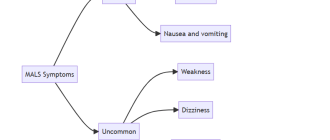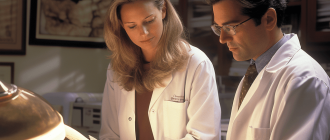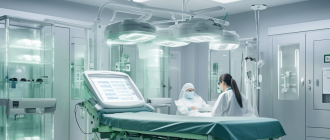 Common Signs and Symptoms of Gastric and Duodenal Ulcers: What to Look Out For
Common Signs and Symptoms of Gastric and Duodenal Ulcers: What to Look Out For
Gastric and duodenal ulcers are common gastrointestinal conditions that can cause discomfort and pain. These ulcers are open sores that develop on the lining of the stomach or the first part of the small intestine, known as the duodenum. While the symptoms of gastric and duodenal ulcers can vary, there are some common signs to look out for.
One of the most common symptoms of gastric and duodenal ulcers is abdominal pain. This pain is typically described as a burning or gnawing sensation that can occur anywhere between the navel and the breastbone. The pain may come and go or be constant, and it can last for minutes to several hours. Some individuals may experience relief from the pain after eating or taking antacids.
Another common sign of gastric and duodenal ulcers is indigestion or dyspepsia. This can include symptoms such as bloating, belching, and a feeling of fullness or discomfort in the upper abdomen. Indigestion may occur after eating or drinking, and it can be worsened by certain foods or beverages.
In some cases, individuals with gastric or duodenal ulcers may experience nausea and vomiting. This can be especially true if the ulcer is located in the stomach. The nausea and vomiting may be accompanied by a loss of appetite and weight loss.
Other signs and symptoms of gastric and duodenal ulcers can include dark or black stools, which may indicate bleeding in the digestive tract, and fatigue or weakness due to anemia caused by chronic bleeding. It is important to seek medical attention if you experience any of these symptoms, as untreated ulcers can lead to complications.
Do duodenal ulcers hurt when you eat?
Yes, duodenal ulcers can cause pain and discomfort when you eat. The pain is typically described as a burning or gnawing sensation in the upper abdomen, just below the breastbone. This pain often occurs between meals or in the middle of the night when the stomach is empty.
The pain associated with duodenal ulcers is caused by the increased production of stomach acid and the erosion of the protective lining of the duodenum. When you eat, the stomach acid comes into contact with the ulcer, causing irritation and pain.
In addition to pain, other symptoms of duodenal ulcers may include:
- Heartburn: A burning sensation in the chest, often after eating or at night.
- Nausea and vomiting: Some people may experience these symptoms, especially if the ulcer is severe or bleeding.
- Loss of appetite: Due to the discomfort and pain associated with eating.
- Unintentional weight loss: This can occur if the pain and discomfort prevent you from eating normally.
- Bloody or dark stools: This may indicate bleeding from the ulcer, which requires immediate medical attention.
If you are experiencing any of these symptoms, it is important to seek medical attention for a proper diagnosis and treatment. Untreated duodenal ulcers can lead to complications, such as perforation or bleeding, which can be life-threatening.
Your doctor may recommend lifestyle changes, medication, or in severe cases, surgery to help manage and heal the ulcers. It is also important to avoid certain foods and beverages that can aggravate the ulcers, such as spicy foods, alcohol, and caffeine.
Remember, if you have any concerns or questions about duodenal ulcers, it is best to consult with a healthcare professional.
They may hurt when the stomach is empty and feel better after eating
Gastric and duodenal ulcers can cause pain that is typically felt in the upper abdomen. One common symptom is that the pain tends to worsen when the stomach is empty, such as between meals or during the night. This is because the stomach acid has nothing to digest, so it can irritate the ulcerated area.
However, it is important to note that not all people with ulcers experience this specific symptom. Some individuals may have pain that is unrelated to eating or may even feel better when the stomach is empty. The severity of the pain can also vary among individuals.
If the pain does worsen when the stomach is empty, it may be relieved or improved by eating or drinking. This is because food or beverages can help neutralize the stomach acid and provide temporary relief. However, it is important to note that this relief is usually temporary and the pain may return after the food or beverage is digested.
It is important to consult a healthcare professional if you suspect you may have a gastric or duodenal ulcer. They can evaluate your symptoms, perform diagnostic tests, and recommend appropriate treatment options to help manage the ulcer and alleviate the associated pain.
Does eating make an ulcer worse?
Contrary to popular belief, eating does not make an ulcer worse. In fact, it is important to eat regular meals to maintain a healthy diet and support the healing process. However, certain foods and beverages can irritate the lining of the stomach or increase the production of stomach acid, leading to increased symptoms and discomfort.
Individuals with gastric or duodenal ulcers should avoid spicy foods, acidic fruits and juices, caffeine, alcohol, and fatty or fried foods, as these can exacerbate symptoms and delay healing. It is also recommended to eat smaller, more frequent meals to prevent excessive stomach acid production.
While eating does not directly worsen an ulcer, it is important to pay attention to how certain foods make you feel. Keeping a food diary and noting any symptoms or discomfort can help identify trigger foods and make necessary adjustments to your diet.
Additionally, it is essential to follow any prescribed medications or treatment plans provided by a healthcare professional. Medications such as proton pump inhibitors or antibiotics may be necessary to reduce stomach acid production and eradicate the bacteria that can cause ulcers.
While eating itself does not make an ulcer worse, certain foods and habits can aggravate symptoms and delay healing. It is important to follow a well-balanced diet, avoid trigger foods, and adhere to any prescribed treatment plans to effectively manage and heal gastric and duodenal ulcers.
For some people eating makes the pain worse, for others better
When it comes to gastric and duodenal ulcers, the relationship between eating and pain can vary from person to person. While some individuals may experience increased pain after eating, others may find that eating actually helps to alleviate their symptoms.
For those whose pain worsens after eating, it is important to understand that certain foods and beverages can irritate the lining of the stomach or duodenum, leading to increased discomfort. Spicy foods, acidic foods, caffeine, alcohol, and fatty or fried foods are common culprits that may trigger or exacerbate ulcer symptoms. In such cases, it may be beneficial to avoid or reduce consumption of these items in order to minimize pain.
On the other hand, there are individuals who find that eating can provide temporary relief from ulcer-related pain. This is because the act of eating can help to neutralize stomach acid and reduce the acidity in the digestive system. Additionally, having some food in the stomach can help to create a protective barrier between the stomach lining and the gastric juices, thus reducing irritation and pain.
It is important to note, however, that this relief is typically temporary and may not last long after the meal. It is also crucial to choose the right types of foods when attempting to alleviate ulcer pain through eating. Opting for bland, easily digestible foods such as oatmeal, yogurt, boiled potatoes, and lean proteins can be more beneficial for individuals with ulcers.
Ultimately, the relationship between eating and pain in gastric and duodenal ulcers is highly individualized. It is important for individuals to pay attention to their own bodies and identify which foods and eating patterns worsen or alleviate their symptoms. Consulting with a healthcare professional can also provide valuable guidance on managing ulcer-related pain through dietary modifications and other treatment options.
Does duodenal ulcer get better after eating?
Contrary to what one might expect, the pain caused by a duodenal ulcer often improves after eating. This is because food helps to neutralize stomach acid and reduce irritation in the duodenum, the first part of the small intestine.
When you eat, the production of stomach acid increases. However, the presence of food in the stomach triggers the release of hormones that inhibit the production of stomach acid. As a result, the acid levels in the stomach decrease, relieving the discomfort caused by the ulcer.
While eating can temporarily alleviate the pain of a duodenal ulcer, it is important to note that this relief is only temporary. The underlying ulcer will still be present and can worsen without proper treatment. Therefore, it is crucial to seek medical attention and follow the prescribed treatment plan to heal the ulcer and prevent complications.
It is also worth mentioning that not all individuals with a duodenal ulcer experience pain relief after eating. Some individuals may continue to experience pain or discomfort even after eating. This can vary depending on the severity and location of the ulcer, as well as individual factors.
If you suspect you have a duodenal ulcer or are experiencing symptoms such as abdominal pain, nausea, or black stools, it is important to consult a healthcare professional for an accurate diagnosis and appropriate treatment.
Usually duodenal ulcer pain improves after eating
One of the distinguishing features of a duodenal ulcer is that the pain tends to improve after eating. This is due to the fact that the presence of food in the stomach helps to neutralize the excess stomach acid that is responsible for causing the ulcer. When food enters the stomach, it triggers the release of digestive juices, including bicarbonate, which helps to neutralize the acid. As a result, the pain associated with a duodenal ulcer typically subsides or becomes less intense after a meal.
It is important to note that while eating may provide temporary relief from duodenal ulcer pain, it is not a long-term solution. In fact, excessive eating or overeating can actually exacerbate the symptoms of a duodenal ulcer. This is because consuming large amounts of food can stimulate the production of more stomach acid, which can irritate the ulcer and worsen the pain. Therefore, it is best to eat small, frequent meals that are low in acidity and avoid foods that are known to trigger ulcer symptoms.
| Signs and Symptoms of a Duodenal Ulcer |
|---|
| Pain or discomfort in the upper abdomen |
| Burning sensation in the stomach |
| Nausea or vomiting |
| Loss of appetite |
| Unexplained weight loss |
| Blood in the stool or vomit |
If you experience any of these symptoms, it is important to consult a healthcare professional for an accurate diagnosis and appropriate treatment. While duodenal ulcers can be managed with medication and lifestyle changes, untreated ulcers can lead to serious complications, such as bleeding or perforation of the stomach or duodenum.
Why does duodenal ulcer get better with food?
One of the key characteristics of a duodenal ulcer is that it tends to improve or feel better after eating. This phenomenon is due to the unique properties of the stomach and the duodenum, the first part of the small intestine.
When we consume food, our stomach releases digestive juices, including hydrochloric acid and pepsin, to break down the food particles. These digestive juices are highly acidic and can be irritating to the lining of the stomach. However, the stomach is equipped with a protective layer of mucus that helps to prevent damage from the acid.
In the case of a duodenal ulcer, the protective layer of mucus in the stomach is compromised, allowing the acid and digestive juices to come into direct contact with the ulcerated area in the duodenum. This can cause pain and discomfort.
However, when food enters the stomach, it stimulates the production of more mucus, which helps to coat and protect the ulcerated area in the duodenum. The food also helps to neutralize the acidity of the digestive juices, reducing their potential for irritation.
Furthermore, the presence of food in the stomach triggers the release of certain hormones, such as gastrin, that stimulate the secretion of bicarbonate, a natural buffer that helps to neutralize the acid. This further contributes to the relief of symptoms associated with a duodenal ulcer.
It is important to note that while eating can provide temporary relief from the symptoms of a duodenal ulcer, it does not address the underlying cause of the ulcer. It is essential to seek medical attention and follow a proper treatment plan to heal the ulcer and prevent its recurrence.
Food neutralizes stomach acid and protects the ulcer
One of the key ways that food can help in the management of gastric and duodenal ulcers is by neutralizing stomach acid. When you eat food, it stimulates the production of stomach acid to aid in digestion. However, certain types of food, such as fruits and vegetables, have an alkaline effect on the stomach, which can help to neutralize excess acid.
By neutralizing stomach acid, food can help to alleviate the pain and discomfort associated with ulcers. It can also help to protect the ulcer itself from further damage. The lining of the stomach and duodenum is naturally coated with a layer of mucus that acts as a protective barrier against stomach acid. When you eat food, it helps to thicken this layer of mucus, providing an additional protective barrier for the ulcer.
Furthermore, certain foods have been found to have healing properties that can promote the repair of gastric and duodenal ulcers. For example, foods rich in antioxidants, such as berries and green leafy vegetables, can help to reduce inflammation and promote the healing of ulcers.
It is important to note that while food can play a role in the management of gastric and duodenal ulcers, it is not a substitute for medical treatment. If you suspect that you have an ulcer, it is important to seek medical advice for an accurate diagnosis and appropriate treatment.
What are the most common ulcer symptoms?
Ulcers can cause a variety of symptoms, and the severity of these symptoms can vary from person to person. However, there are several common symptoms that are often associated with gastric and duodenal ulcers:
1. Abdominal pain: The most common symptom of an ulcer is a persistent pain or discomfort in the abdominal area. This pain can range from a dull ache to a sharp, burning sensation. It is usually located in the upper abdomen, just below the breastbone.
2. Nausea and vomiting: Many people with ulcers experience feelings of nausea and may even vomit. This can be especially true if the ulcer is located in the stomach.
3. Loss of appetite: Ulcers can cause a decrease in appetite, leading to weight loss and malnutrition if left untreated.
4. Heartburn: Some individuals with ulcers may experience a burning sensation in the chest, known as heartburn. This can often be mistaken for acid reflux or gastroesophageal reflux disease (GERD).
5. Indigestion: Dyspepsia, or indigestion, is a common symptom of ulcers. It can cause feelings of fullness, bloating, and discomfort after eating.
6. Fatigue: Chronic ulcers can lead to fatigue and a general feeling of weakness. This is often due to the body’s decreased ability to absorb nutrients properly.
7. Blood in the stool or vomit: In some cases, ulcers can cause bleeding in the digestive tract, resulting in the presence of blood in the stool or vomit. This is a serious symptom and requires immediate medical attention.
If you experience any of these symptoms, it is important to consult a healthcare professional for a proper diagnosis and treatment. Ignoring ulcer symptoms can lead to complications, such as perforation or bleeding, which can be life-threatening.
Abdominal pain
Abdominal pain is one of the most common symptoms of gastric and duodenal ulcers. It is usually described as a burning or gnawing sensation that is located in the upper abdomen. The pain may come and go, and its severity can vary from mild to severe.
In some cases, the pain may be worse when the stomach is empty, and it may improve after eating or taking antacids. This is because the stomach acid can irritate the ulcer, causing pain. The pain may also be worse at night or in the early morning.
Abdominal pain can sometimes be accompanied by other symptoms, such as bloating, nausea, vomiting, and loss of appetite. These symptoms can vary depending on the location and severity of the ulcer.
If you experience persistent or severe abdominal pain, it is important to see a doctor for a proper diagnosis. They can perform tests, such as an endoscopy or an X-ray, to determine the cause of the pain and recommend appropriate treatment.
Bloating
Bloating is a common symptom of gastric and duodenal ulcers. It refers to a feeling of fullness or tightness in the abdomen, often accompanied by a visible distention of the stomach. Bloating can be caused by the accumulation of gas or fluid in the digestive system.
When an ulcer develops in the stomach or duodenum, the normal flow of digestive juices is disrupted. This can lead to problems with digestion and can cause food to remain in the stomach for longer periods of time. As a result, gas can build up, causing the abdomen to bloat.
In addition to bloating, individuals with gastric or duodenal ulcers may experience other symptoms such as abdominal pain, heartburn, nausea, and vomiting. These symptoms can vary in severity and may come and go.
If you are experiencing bloating or other symptoms associated with gastric or duodenal ulcers, it is important to seek medical attention. A healthcare professional can diagnose the underlying cause of your symptoms and recommend appropriate treatment options.
Treatment for gastric and duodenal ulcers often involves a combination of medications to reduce stomach acid and promote healing, as well as lifestyle changes such as avoiding certain foods and managing stress. It is important to follow your healthcare provider’s recommendations and take any prescribed medications as directed.
Bloating is a common symptom of gastric and duodenal ulcers. If you are experiencing bloating or other symptoms associated with these conditions, it is important to seek medical attention for an accurate diagnosis and appropriate treatment.
Nausea
Nausea is a common symptom associated with gastric and duodenal ulcers. It is characterized by a feeling of unease and discomfort in the stomach, usually accompanied by the urge to vomit. Nausea can be intermittent or persistent and may worsen after eating or drinking. It is often accompanied by other symptoms such as abdominal pain, bloating, and loss of appetite.
Nausea occurs as a result of the irritation and inflammation of the stomach lining caused by the ulcer. The presence of excess acid in the stomach can further exacerbate this symptom. Nausea can be mild to severe and can significantly impact a person’s quality of life.
If you experience persistent or severe nausea, it is important to seek medical attention. Your doctor can evaluate your symptoms and determine the underlying cause. Treatment for nausea associated with gastric and duodenal ulcers may include medications to reduce acid production, antibiotics to treat any bacterial infections, and lifestyle changes such as avoiding trigger foods and reducing stress.
Vomiting
Vomiting is a common symptom of gastric and duodenal ulcers. It occurs when the stomach contents are forcefully expelled through the mouth. Vomiting can be a result of irritation and inflammation in the stomach lining caused by an ulcer.
Some common signs and symptoms of vomiting associated with ulcers include:
- Feeling nauseous before vomiting
- Experiencing a burning sensation in the stomach or upper abdomen
- Having an acidic taste in the mouth before vomiting
- Feeling relief after vomiting
Vomiting can occur both before and after meals, and it may be accompanied by other symptoms such as abdominal pain, bloating, and loss of appetite. It is important to seek medical attention if vomiting persists or is severe, as it can lead to dehydration and other complications.
How do MALS symptoms differ from ulcer symptoms?
Median Arcuate Ligament Syndrome (MALS) is a rare condition that affects the blood supply to the stomach, liver, and intestines. It is often characterized by chronic abdominal pain, which can be similar to the symptoms of gastric and duodenal ulcers. However, there are some key differences in the symptoms of MALS compared to ulcers.
| MALS Symptoms | Ulcer Symptoms |
|---|---|
| Chronic abdominal pain that worsens after eating | Episodic abdominal pain that may be relieved by eating |
| Weight loss | Weight loss or gain |
| Nausea and vomiting | Nausea and vomiting |
| Difficulty eating or feeling full quickly | Heartburn or indigestion |
| Diarrhea | Bloody or tarry stools |
| Changes in bowel movements | Changes in bowel movements |
It is important to note that these symptoms can vary from person to person, and some individuals may experience a combination of both MALS and ulcer symptoms. Additionally, MALS is typically diagnosed through imaging tests such as ultrasound or CT scan, while ulcers are often diagnosed through endoscopy or other invasive procedures.
If you are experiencing any of these symptoms, it is important to consult with a healthcare professional for an accurate diagnosis and appropriate treatment plan.
MALS causes post-prandial pain while ulcers cause pain on an empty stomach
Median arcuate ligament syndrome (MALS) is a disorder characterized by compression of the celiac artery by the median arcuate ligament, resulting in decreased blood flow to the stomach and intestines. This compression can cause post-prandial pain, which refers to pain that occurs after eating a meal. The pain is typically located in the upper abdomen and can be described as a dull ache or a feeling of fullness.
In contrast, gastric and duodenal ulcers are open sores that develop on the lining of the stomach or the first part of the small intestine, respectively. These ulcers can cause pain that is typically felt on an empty stomach, between meals, or during the night. The pain can be described as a burning or gnawing sensation and may be relieved by eating or taking antacids.
| MALS | Gastric and Duodenal Ulcers |
|---|---|
| Post-prandial pain | Pain on an empty stomach |
| Located in the upper abdomen | Felt in the stomach or small intestine |
| Dull ache or feeling of fullness | Burning or gnawing sensation |
| Relieved by eating | May be relieved by eating or taking antacids |
It is important to note that while MALS and ulcers can both cause abdominal pain, the timing and characteristics of the pain can help differentiate between the two conditions. If you are experiencing persistent or severe abdominal pain, it is recommended to consult with a healthcare professional for proper diagnosis and treatment.
Question-answer:
What are the common signs of gastric ulcers?
Common signs of gastric ulcers include abdominal pain, bloating, heartburn, nausea, and loss of appetite.
How can I differentiate between gastric and duodenal ulcers?
Gastric ulcers typically cause pain in the upper abdomen, while duodenal ulcers often cause pain in the lower chest or upper abdomen.
What are the symptoms of duodenal ulcers?
Symptoms of duodenal ulcers may include abdominal pain, which is usually relieved by eating or taking antacids, weight loss, bloating, and vomiting.
When should I seek medical attention for ulcer symptoms?
You should seek medical attention if you experience severe abdominal pain, persistent vomiting, black or bloody stools, or if your symptoms worsen or do not improve with over-the-counter medications.
Can stress contribute to the development of ulcers?
Yes, stress can contribute to the development of ulcers by increasing stomach acid production and weakening the protective lining of the stomach and duodenum.
What are the signs and symptoms of gastric and duodenal ulcers?
The signs and symptoms of gastric and duodenal ulcers can include abdominal pain, which is often described as a burning or gnawing sensation. Other common symptoms include bloating, nausea, vomiting, weight loss, and appetite changes.
How can I differentiate between gastric and duodenal ulcers?
Gastric ulcers are located in the stomach, while duodenal ulcers are located in the duodenum, which is the first part of the small intestine. The symptoms of gastric and duodenal ulcers can be similar, but gastric ulcers often cause pain that worsens with eating, while duodenal ulcers tend to cause pain that improves with eating.
What are some risk factors for developing gastric and duodenal ulcers?
Some risk factors for developing gastric and duodenal ulcers include infection with Helicobacter pylori bacteria, long-term use of nonsteroidal anti-inflammatory drugs (NSAIDs), smoking, excessive alcohol consumption, and stress.
When should I see a doctor if I suspect I have a gastric or duodenal ulcer?
You should see a doctor if you experience persistent abdominal pain, especially if it is severe or worsens over time. Other reasons to seek medical attention include vomiting blood or dark, tarry stools, unexplained weight loss, and difficulty swallowing.
How are gastric and duodenal ulcers diagnosed?
Gastric and duodenal ulcers can be diagnosed through several methods. These may include endoscopy, where a thin tube with a camera is inserted into the digestive tract to visualize the ulcers, as well as blood tests to check for infection with H. pylori bacteria. In some cases, a biopsy may be taken during endoscopy to examine the tissue for signs of cancer.






